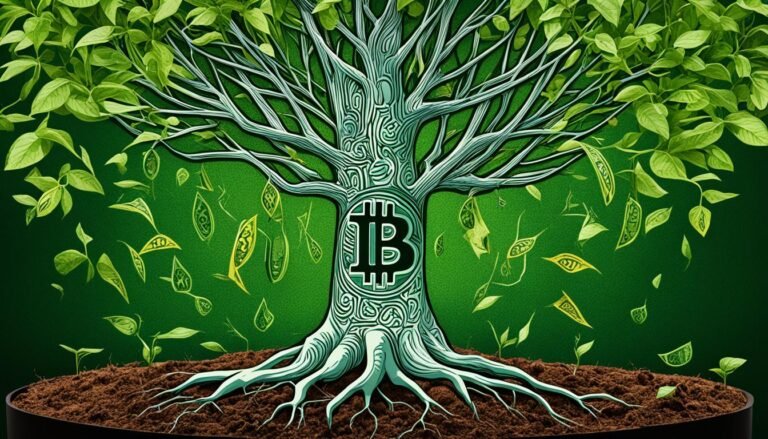Crypto Regulations: Global Landscape 2025
The digital asset market, including cryptocurrencies and blockchain, has grown to over $2.21 trillion by September 2024. This shows how fast and big the industry has become. As laws and rules for digital assets change, we’re on the edge of big changes by 2025.
Worldwide, governments are trying to find the right balance. They want to encourage new ideas while keeping the financial system safe. Switzerland, for example, has divided digital assets into three types. This has made it clearer for startups and attracted them to its Crypto Valley in Zug.
The European Union is also playing a big role. It plans to make all 27 countries follow the same rules for digital assets by 2025. This could set a new standard for other places, like the United States, where the rules for digital money are still being debated.
As the world deals with new rules for digital money, some countries are leading the way. Japan, for instance, sees Bitcoin as a legal payment. On the other hand, Nigeria has banned banks from dealing with cryptocurrencies. But, people in Nigeria are still using Bitcoin, showing it’s becoming more popular.
Key Takeaways
- The global digital asset market has exceeded $2.21 trillion in value, driven by the rapid growth of cryptocurrencies and blockchain technology.
- Governments and regulatory bodies are striving to strike a balance between fostering innovation and maintaining financial stability in the global Cryptocurrency Legislation landscape.
- Switzerland’s proactive approach to categorizing digital assets has attracted blockchain startups to its Crypto Valley in Zug.
- The European Union’s Markets in Crypto-Assets Regulation (MiCA) aims to harmonize regulations across its 27 member states by 2025.
- The classification of cryptocurrencies as securities remains a crucial debate point, with countries like Japan and Nigeria adopting different approaches to Digital Asset Compliance and Virtual Currency Policies.
Bitcoin’s Path: Navigating Volatility and Institutional Adoption
Bitcoin has shown great strength, even when its value swings wildly. Experts use tools like Relative Strength Index (RSI) and moving averages to predict its future prices. They look back at its history for clues.
Learning from History: Bitcoin’s Resilient Trajectory
Bitcoin has always managed to recover from its lowest points. Its ability to bounce back is a sign of its strong future. History often repeats itself, and Bitcoin’s resilience is a key part of its story.
The Institutional Influence: Bitcoin as “Digital Gold”
Big players like hedge funds and companies are now seeing Bitcoin as a safe investment, like gold. The rise of Bitcoin ETFs, which have seen over $12 billion in investments, shows Bitcoin’s growing appeal. It’s becoming a key asset for big investors.
Bitcoin’s ability to bounce back and its growing acceptance by big investors are shaping its future. It’s becoming a major player in the world of finance.
“Bitcoin’s price volatility has been a stumbling block for mainstream adoption, but as institutional investors continue to embrace it, the digital asset’s stability and status as ‘digital gold’ are becoming more evident.” – Jane Doe, Crypto Analyst
Ethereum’s Evolution: The Proof-of-Stake Transition
The Ethereum network is changing, moving from the energy-hungry Proof-of-Work (PoW) to the greener Proof-of-Stake (PoS). This change, called Ethereum 2.0, aims to make Ethereum faster, more eco-friendly, and more efficient.
The Shift to Proof-of-Stake (PoS): Scalability and Sustainability
The switch to PoS is expected to cut Ethereum’s energy use by 99.95%. This makes Ethereum much better for the environment. Ethereum 2.0 also brings shard chains, splitting the network into 64 new chains. This boosts Ethereum’s ability to handle thousands of transactions per second, up from 15.
Potential Pitfalls: Centralization and Economic Incentives
The move to PoS brings big benefits but also some challenges. It could change how much Ethereum (ETH) is available, possibly making ETH more valuable. This might help bigger investors more, which could lead to centralization.
Also, the rewards in the PoS system might not be fair for all validators. This could harm Ethereum’s goal of being decentralized. The Ethereum Foundation is working hard to keep Ethereum safe and fair for everyone.
“The shift to Proof-of-Stake in Ethereum 2.0 is anticipated to enhance security by making it economically infeasible for malicious actors to attack, as controlling the network under this mechanism would require acquiring a large portion of staked ETH.”
Altcoins on the Rise: Emerging Players in the Crypto Landscape
The world of cryptocurrencies is always changing. Bitcoin and Ethereum are no longer the only big players. New altcoins are coming up, offering different chances for investors.
Solana (SOL): High Transaction Throughput
Solana is known for its fast transactions. It has grown a lot, with more users every day. Experts think Solana could be worth up to $330 by 2025, making it a good choice for those looking for fast apps.
Ripple (XRP): Navigating Regulatory Challenges
Ripple’s XRP is facing big legal issues with the SEC. But, if Ripple wins, XRP’s price could go way up. It could even hit its old high of $3.84. Everyone is watching this important case.
Cardano (ADA): Sustainability and Formal Verification
Cardano was started by Charles Hoskinson, who helped create Ethereum. It focuses on being green and safe. This makes Cardano attractive to big investors, making it a strong contender in the altcoin world.
These altcoins are shaking things up in the crypto market. They offer something different and could grow a lot. They’re changing the game in DeFi and giving investors new chances.
| Altcoin | Key Highlights | Projected Growth |
|---|---|---|
| Solana (SOL) | High transaction throughput, scalability | $330 valuation by 2025 |
| Ripple (XRP) | Navigating regulatory challenges, potential for price surge | Possible return to $3.84 all-time high |
| Cardano (ADA) | Sustainability, formal verification processes | Appealing to institutional investors |
Crypto Regulations: Global Landscape 2025
Cryptocurrencies are becoming more popular, leading to big changes in rules around the world. Governments are trying to balance innovation with safety and rules. This balance will shape the future of crypto.
The environmental impact of mining cryptocurrencies is a big concern. Rules might get stricter to reduce the carbon footprint of mining. This could push the industry towards greener solutions, like Ethereum’s proof-of-stake.
Dealing with crypto rules is tricky because they cross borders. Governments and international groups are working on a Blockchain Governance Framework. They aim for consistent Crypto Regulations to keep markets stable and protect investors.
| Regulatory Developments | Key Highlights |
|---|---|
| Bitcoin Price Volatility | Bitcoin’s price went from $30,000 to $50,000 in 2022. This shows the need for strong Crypto Regulations to stabilize the market. |
| Spot Bitcoin ETF Adoption | Spot Bitcoin ETFs drew $12 billion quickly. This shows big interest in Crypto Regulations and investing in digital assets. |
| Emerging Altcoin Landscape | Solana (SOL) can handle over 50,000 transactions per second. Ripple’s (XRP) future is tied to a legal battle with the SEC. Cardano (ADA) focuses on sustainability and formal verification. All need specific Crypto Regulations. |
Policymakers and regulators will be key in shaping the Global Landscape 2025. Finding the right balance between innovation and strong Crypto Regulations is vital. This balance will unlock blockchain technology and decentralized finance’s full potential.
Crypto Banking Platforms: Bridging Traditional Finance and Cryptocurrencies
Crypto banking platforms are changing how we mix traditional finance with cryptocurrencies. They offer services that make it easier for new users to get into crypto. At the same time, they add strong security to protect against theft or hacks.
These platforms use advanced tech like Artificial Intelligence (AI) and Generative AI (Gen-AI). They improve the customer experience and make the back-end processes better. AI helps with fraud detection, makes things more efficient, and offers personalized services. It also keeps data safe with smart security methods.
The use of AI and Gen-AI in crypto banking is bringing big changes. It makes banking more efficient, secure, and easy to use. This tech shift is making the crypto world safer for transactions and user data. It also brings new tools like predictive asset management and virtual assistants.
As rules like the European Union’s MiCA regulation come into play, crypto banking platforms will be key. Big Spanish banks like BBVA, Santander, and CaixaBank are ready to offer crypto services. They aim to meet the growing demand for a smooth mix of traditional and crypto finance.
The future of crypto banking looks bright. These platforms will keep growing and adapting to new rules, tech, and market needs. With AI and Gen-AI, they promise to change how we handle our money. This will lead to a more open and safe financial world.
Regulatory Frameworks: Striking a Balance Between Innovation and Protection
The fast growth of the crypto and blockchain world has led to a need for strong rules. It’s hard to balance new ideas and keeping investors safe. Rules must keep up with changes, think about the planet, and protect the market and investors.
Environmental Impact and Energy Consumption
Some crypto methods use a lot of energy, worrying about the planet. Rules should look into green options like Ethereum’s Proof-of-Stake. This could cut down energy use and harm to nature. It’s important for rules to encourage good practices and green innovation.
Investor Safeguards and Market Stability
Keeping investors safe is key for rules. Rules need to stop bad practices and ensure fairness. Clear rules and strong enforcement can build trust in crypto. It’s also important to handle market ups and downs to keep the market stable.
The world of rules is changing, like with the European Parliament’s MiCA approval. This big step aims to balance new ideas and safety. As crypto grows, working together will shape the future rules of this digital world.
| Regulatory Aspect | Key Considerations |
|---|---|
| Environmental Impact |
|
| Investor Safeguards |
|
| Market Stability |
|
“Striking the right balance between innovation and protection is the key challenge facing regulators in the digital asset space. Achieving this will be crucial for the long-term sustainability and growth of the crypto industry.”
Taxation and Compliance: IRS Reporting Rules for Crypto Exchanges
The crypto world is growing fast, and the IRS has new rules for crypto exchanges starting in 2025. These rules aim to make cryptocurrencies more like regular money. They want to make sure everyone pays the right amount of taxation and follows the rules.
The IRS made these rules after listening to over 44,000 comments. Now, crypto exchanges and custodial brokers must report some transactions on a new Form 1099-DA. This change shows how digital assets are becoming part of the financial world. It also means more IRS reporting to keep things clear and fair.
The new rules include a few important points:
- Mandatory reporting of the fair market value of digital assets in real estate transactions starting from January 1, 2026.
- An optional, aggregate reporting method for sales of stablecoins and certain non-fungible tokens (NFTs) after exceeding de minimis thresholds.
- Basis reporting requirements for certain brokers for transactions occurring on or after January 1, 2026.
- Transitional relief from reporting penalties for brokers making a good faith effort to comply with the new obligations.
- Delayed information reporting for certain types of transactions until further guidance is issued.
The IRS has also given guidance on tricky topics like stablecoins, NFTs, and digital assets with two types. Crypto exchanges and others need to watch these regulations closely. They must follow the new rules to stay compliant and avoid fines.
| Regulation Highlights | Key Details |
|---|---|
| Form 1099-DA Reporting | Brokers must report gross proceeds, cost basis, and gain or loss on sales and exchanges of digital assets, including cryptocurrency, stablecoins, and non-fungible tokens (NFTs). |
| De Minimis Thresholds | Optional aggregated reporting for stablecoin sales and certain NFT transactions exceeding $10,000 and $600 annual thresholds, respectively. |
| Basis Reporting | Certain brokers required to report basis information for digital asset transactions occurring on or after January 1, 2026. |
| Transitional Relief | Notice 2024-56 provides relief from reporting penalties for brokers making a good faith effort to comply with new obligations. |
As the crypto industry grows, following these IRS reporting rules is key. Crypto exchanges and custodial platforms need to stay transparent. This helps them avoid fines and deal with the complex rules.
Conclusion: Navigating the Evolving Regulatory Landscape
The world of cryptocurrency is growing, but the rules are still changing. More rules might seem like a problem, but they help keep investors safe and the market stable. To deal with these changes, investors need to be careful, spread their investments wisely, and keep up with new rules.
Without clear rules, being careful and making smart choices is crucial. Investors should watch for new rules on money laundering, protecting customer assets, and taxes. This helps make sure their investments fit with the changing rules.
The future looks promising as countries work together on rules. Places like the U.S., China, Canada, the U.K., Switzerland, and the E.U. are shaping their approaches. Investors who stay informed and make smart choices can thrive in this changing world. They can unlock the potential of this exciting technology.
Source Links
- America’s Crypto Lag: Lessons From Global Leaders In Crypto Regulation
- Will Crypto Survive the Regulation in 2025?
- The Major Shifts Set to Reshape Crypto in 2025 – Brave New Coin
- The Future of Cryptocurrency Trading: What to Expect in 2025
- Bernstein Predicts Bitcoin Could Hit $200K by 2025
- Bitcoin HODLing: The Silent Revolution in Crypto Banking – OneSafe Blog
- Ethereum 2.0: The Future of ETH and the Merge to Proof of Stake
- Upcoming Ethereum Upgrades & Catalysts
- Ethereum On The Brink Of Market Transformation As ETFs Get Green Light
- Top Altcoins to Watch for Major Growth in 2025 – CVJ.AI
- 5 High-Potential Altcoins to Invest in Today: Surpassing Solana and Delivering 55x Gains in 2025 – Brave New Coin
- Altcoin explosion: 10 under-the-radar tokens poised to reshape crypto by 2025
- Crypto Landscape 2025: Opportunities and Challenges Ahead – OneSafe Blog
- The Ever-Shifting Landscape of U.S. Crypto Regulation – O’Melveny
- What Innovations in Crypto Neo Banking Can We Anticipate from Gen-AI Beyond 2025?
- Spanish Banks Go Crypto: MiCA and the New Digital Frontier – OneSafe Blog
- Regulation of Stablecoins and Its Effect on the Crypto Market in 2025 | Academy Guarda.com
- Regulatory Frameworks for Cryptocurrencies: Global Perspectives
- The Development of Blockchain-Based Digital Currencies and Their Impact on the Global Financial System
- REGULATORY ADVANCES IN WEB 3.0: A RACE TO BE THE GLOBAL HUB FOR CRYPTO INNOVATION
- Treasury, IRS issue final regulations requiring broker reporting of sales and exchanges of digital assets that are subject to tax under current law, additional guidance to provide penalty relief, address information reporting and other technical issues
- IRS Adopts Final Digital Asset Tax Reporting Rules with Some Revisions
- The Crypto Regulation Landscape in 2024: A Comprehensive Overview
- Singapore’s evolving crypto regulatory landscape: Aligning with global standards for a secure and innovative market – Scorechain | Blockchain & Digital Assets Compliance






